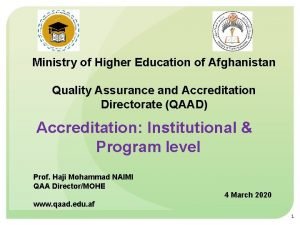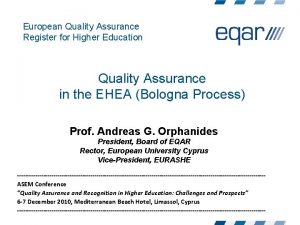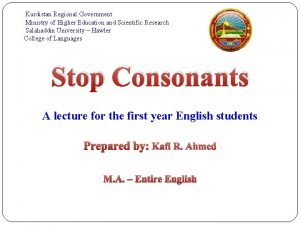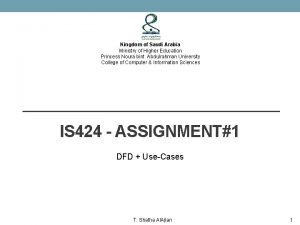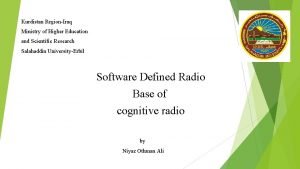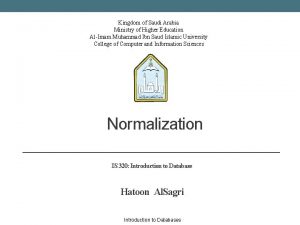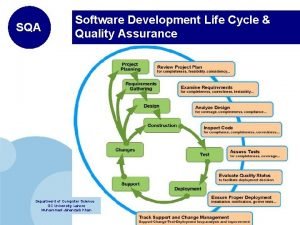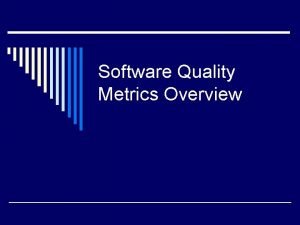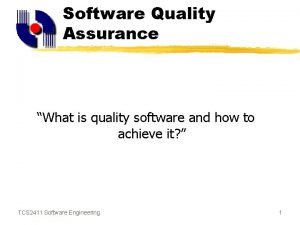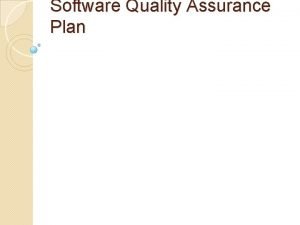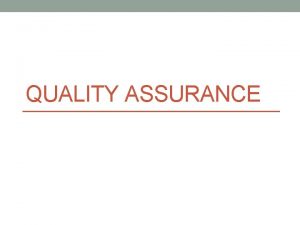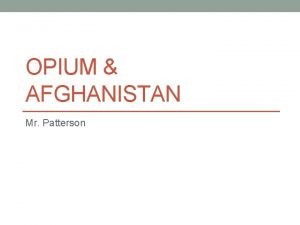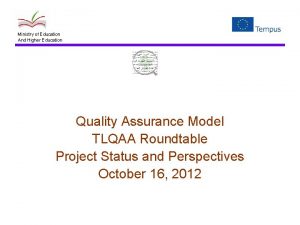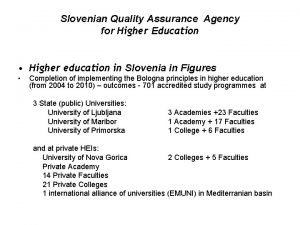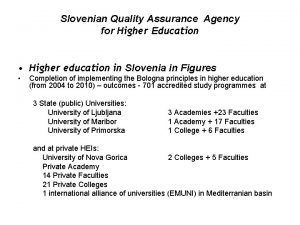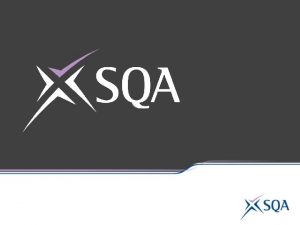Ministry of Higher Education of Afghanistan Quality Assurance



















- Slides: 19

Ministry of Higher Education of Afghanistan Quality Assurance and Accreditation Directorate (QAAD) Accreditation: Institutional & Program level Prof. Haji Mohammad NAIMI QAA Director/MOHE 4 March 2020 www. qaad. edu. af 1

Outline q q q Need for QAA history in Afghanistan Progress of QAA in HEIs of Afghanistan Functions of accreditation Standards of institutional and program accreditation q Accreditation process q Challenges

The Need for Quality Assurance and Accreditation (QAA) § Massification of Higher Education § Poor capacity of institutions § International recognition of degrees and credits § Poor quality educational services § Lack of a systematic evaluation mechanism

Accreditation and Quality Assurance in Higher Education of Afghanistan Government Ministry of Higher Education QAAD Board 4

Sustainability and Strengths of QAA at Macro, Meso & Micro Level National Level • Establishment of Quality Assurance and Accreditation Directorate • Development of a system to oversee quality • Capacity building of QAA members, staff and peer-reviewers Institutional Level • Establishment of internal quality assurance units (IQAU) and organizational structures • Development of strategic plans at each institution • Development of operation plans (work plan) • Regular self-assessment each year (APM) Faculty/Program Level • Establishment of sub-QA units at each faculty/program • Regular assessment of courses through Annual program monitoring • Development of individual plans

Types of Accreditation There are two basic types of educational accreditation: Institutional accreditation normally applies to an entire institution. Specialized or programmatic accreditation normally applies to programs, departments, or faculties that are parts of an institution, generally specialized 6

History of accreditation in Afghanistan 20042008 2011 National Higher Education Strategic Plans outline the establishment of a quality assurance system. 2011 Workshops and seminars were conducted by Commission members Directorate of Quality Assurance was established in the Mo. HE and initial accreditation framework drafted 2012 By-laws approved 7

History of accreditation in Afghanistan 20122015 More than 50 Universities (Public and Private) applied for and were placed in initial candidacy status Joined APQN (Asia Pacific Quality Network) 2016 Initial Framework and Accreditation Process was revised (based on feedback from universities) 2016 Pilot was conducted with 8 universities (4 public and 4 private). 2016 8

History of accreditation in Afghanistan 2017 2020 Based on feedback from the Pilot the framework and process was revised Accreditation framework for program level drafted and approved Pilot started with 3 private and 6 public Universities 9

Number of Institutions Accredited by QAAD 8

Progress inside HEIs after implementation of Accreditation framework Governance Staff employme nt Partnerships Committees function APR Research OBE and SCL, OBA Vison and Mission Strategic plan & implementa tion Library and information resources Program catalogue

Functions of Accreditation serves several major purposes: Assures government, business and public of quality Eliminates institutions that are fraudulent or poor quality and thus protects students and the public Ease of degree recognition and credit transfer Easy to establish a new program Facilitating international accreditation Meets international expectations of employers, NGOs and governments 12

Moving away from just counting…


Standards of institutional Accreditation 1. Mission, Vision and Strategy 2. Contribution to Society 3. Governance, Leadership and Administration 4. Financial Resources and Management 5. Academic Programs 6. Research 7. Faculty Members and Staff 8. Student Experience 9. Quality Assurance and Enhancement 10. Library and Information Resources 11. Teaching, Information and Facilities 15

Standards of program Accreditation 1. Mission, vision and Strategy 2. Program design and teaching-learning methods 3. Students assessment 4. Governance, leadership and management 5. Financial resources and management 6. Academic activities 7. Faculty Members and Staff 8. Student services and enrollment 9. Quality Assurance and Enhancement 10. Library and Information Resources 11. Information technology Facilities 12. Research 16

Accreditation Process (3 Phases) 1. University SAR 2. Peer Review 3. QA Board Review Depending on QA Board Decision Full Accreditation Monitoring Process

Challenges § Limited understanding of quality assurance by some university leadership and faculty members § Institutional accreditation is challenging in big Universities § The old standards and process were difficult to navigate § Some standards are not achievable with limited resources.

 Ministry of higher education afghanistan
Ministry of higher education afghanistan European quality assurance
European quality assurance Ministry of education krg
Ministry of education krg Ministry of higher education kurdistan
Ministry of higher education kurdistan Kurdistan
Kurdistan Ministry of higher education saudi arabia
Ministry of higher education saudi arabia Ministry of higher education kurdistan
Ministry of higher education kurdistan Ministry of higher education tunisia
Ministry of higher education tunisia Ministry of higher education saudi
Ministry of higher education saudi Quality assurance vs quality control
Quality assurance vs quality control Project quality management pmp
Project quality management pmp Pmp gold plating
Pmp gold plating Define quality assurance in nursing
Define quality assurance in nursing Compliance vs quality
Compliance vs quality Concepts of quality control
Concepts of quality control Sqa software development
Sqa software development Software testing and quality assurance theory and practice
Software testing and quality assurance theory and practice Defect arrival pattern
Defect arrival pattern Software quality assurance iso standards
Software quality assurance iso standards Software quality assurance planning
Software quality assurance planning
